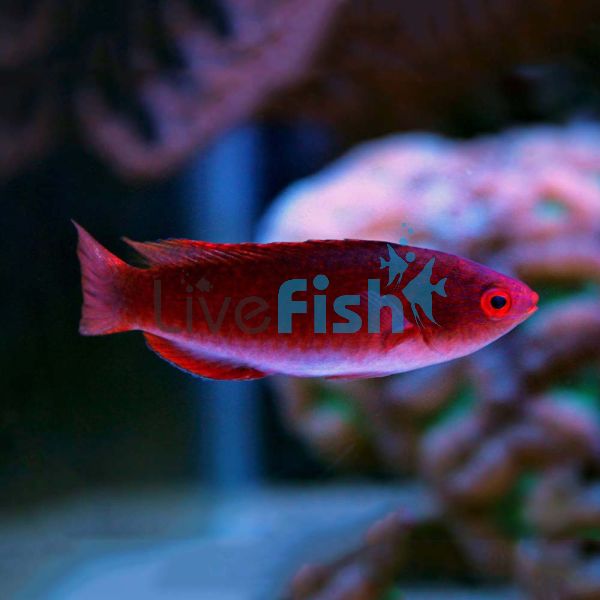Red Fin Fairy Wrasse MED
The Red Fin Fairy Wrasse is a bright addition to any aquarium. It is generally happiest as part of a school.
RedFin Fairy Wrasse
The Red Fin Fairy Wrasse can be a variety of colours that change according to mood. Commonly, the male is red with a white belly, faint stripes and red fins, while the female is yellowish with a red tail. Males are brighter than females, these colours intensify when attracting females.
There are no reports of breeding in a home aquarium. The Redfin Fairy Wrasse is a protogynous hermaphrodite. If required, the biggest female will change sex if a male dies or is removed from a group. It is an egg scattering fish, whose eggs are pelagic. Mating usually occurs in open water. Eggs and larvae will float with plankton before sinking to the reef.
This species is found in the Western-Pacific region around Indonesia and the Philippines. Their natural habitat is in reefs amongst currents, over rubble and rockwork. Usually between depths of 2-40 metres.
Tank Recommendations for your Redfin Fairy Wrasse
Aquarium capacity should be at least 90 gallons (340.6 litres) capacity.
The Red Fin Fairy Wrasse can stay in a reef or fish-only aquarium. However, it is best suited to a reef tank as they do not pose any danger to corals or invertebrates. They are used to a reef environment with rock and rubble, so an aquarium should be similar.
Water should be aerated and of high quality. Cover the tank with a secure canopy as this species can jump out of the tank.
Suitable Tank Buddies
The Redfin Fairy Wrasse has a peaceful temperament. However, it may be aggressive with conspecifics. it is best suited to cohabiting with peaceful tank buddies.
Bigger more intimidating fish are unsuitable for cohabiting with the Red Fin Wrasse.
Usually Compatible
There are a variety of suitable companions for Red Fin Fairy Wrasse. Examples include Fairy Basslets, Tilefish, small Cardinalfish, Gobies, and Butterflyfish.
Sometime Compatible
A group of conspecifics should contain a male and a number of females. Only house two males together if an aquarium is sufficiently large. Introduce the group at the same time, or add the females before the male. RedFin Fairy Wrasse should be added after small aggressive fish but before larger fish.
Rarely Compatible
Avoid Frogfish, Lionfish, Groupers, and any other fish that can eat it. Bigger Tangs and Angelfish may intimidate the Red Fin Fairy Wrasse. Slow movers such as Seahorses and Pipefish won't be able to compete for food. Smaller shy planktivores like Dottybacks may also find this species too boisterous.
Feeding your Pintail Fairy Wrasse
The Redfin Fairy Wrasse is a carnivore. Suitable food includes mysis shrimp, vitamin-enriched brine shrimp, plankton, and chopped krill. Over time it may become accustomed to flake food. Feed several times per day.
| Scientific Name | Cirrhilabrus rubripinnis |
|---|---|
| Care Level | Easy |
| Common Names | Red Fin Fairy Wrasse, Red Fin Wrasse, Red Parrot Wrasse, Philippine Flame Wrasse, Yellow-Flanked Fairy Wrasse, Purple Head Parrot, Red Fairy Wrasse, Purple Fairy Wrasse, Red Parrot Fairy Wrasse. |
| Diet | Carnivore |
| Fish Family | Labridae |
| Lifespan (years) | 4 |
| Max. Length (cm) | 10 |
| Min. Tank Volume (l) | 341 |
| Origin | Western-Pacific; Indonesia, the Philippines. |
| Reef Safe | Yes |
| Sociability | Peaceful |
| Venomous | No |
| Water Conditions | 22.2-25.5° C (72-78° F), dKH 8-12, pH 8.1-8.4, sg 1.020-1.025 |




